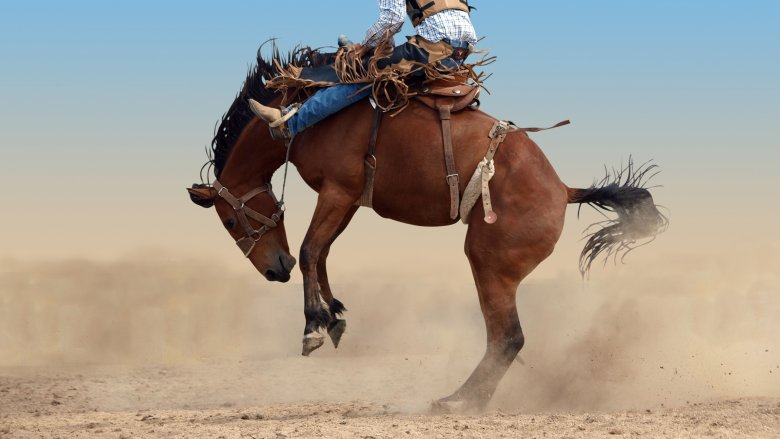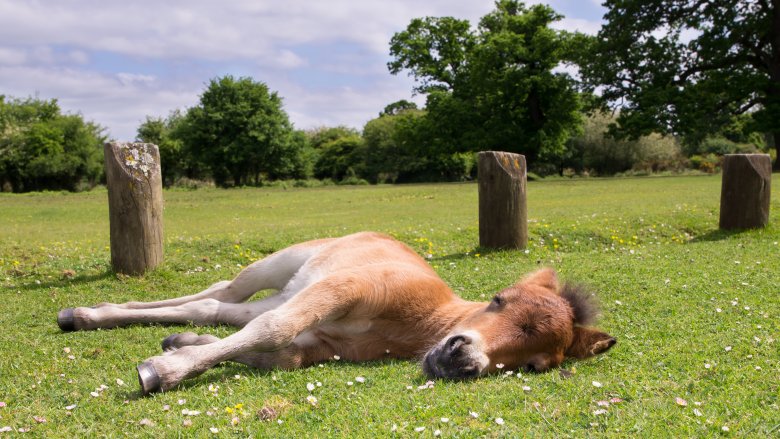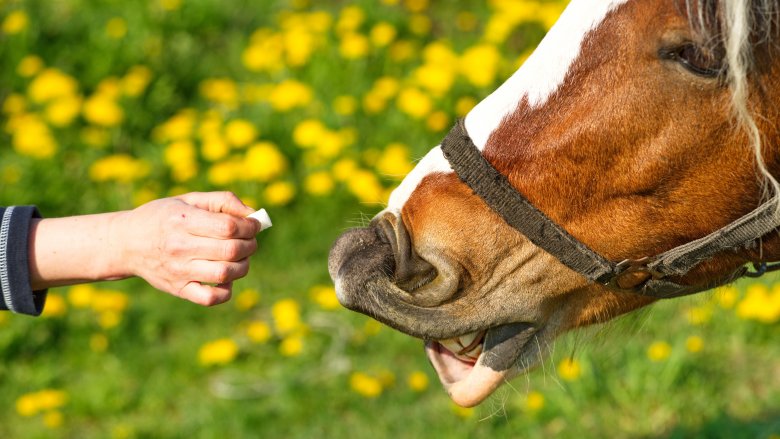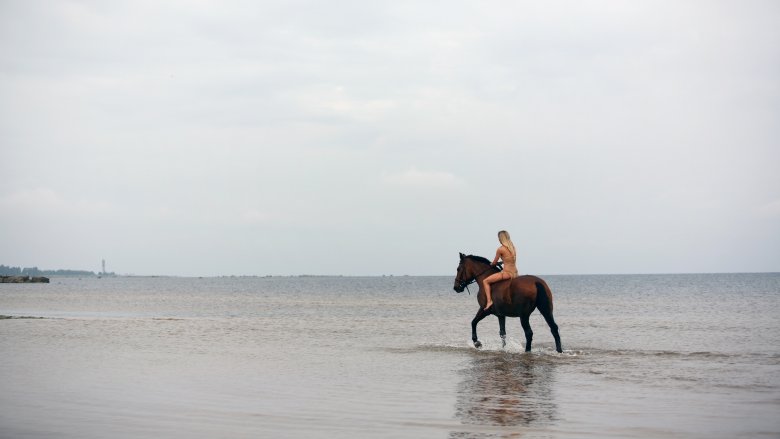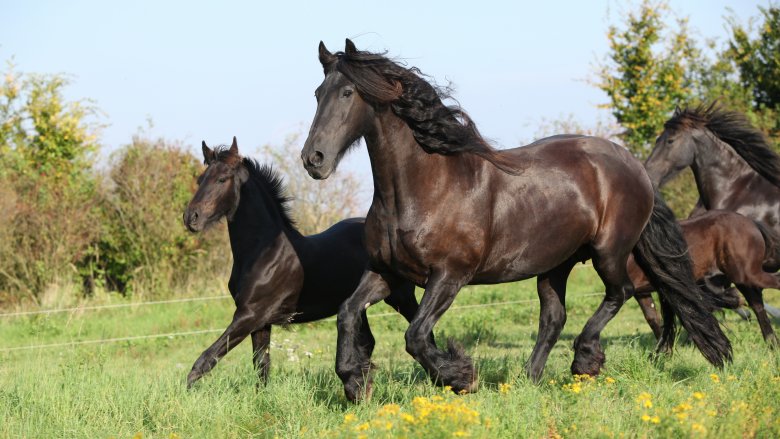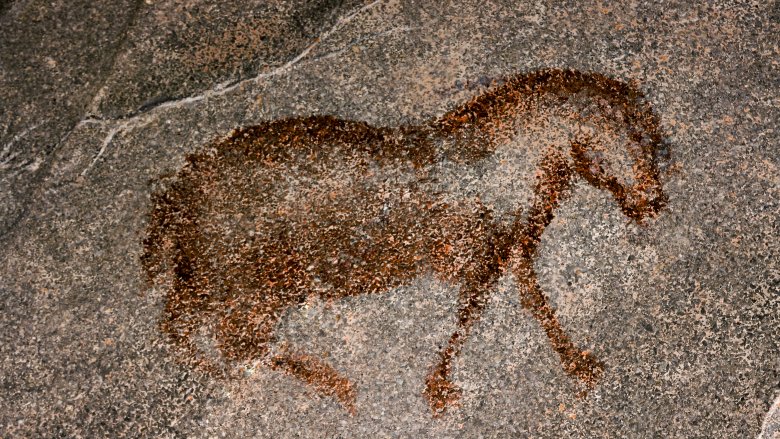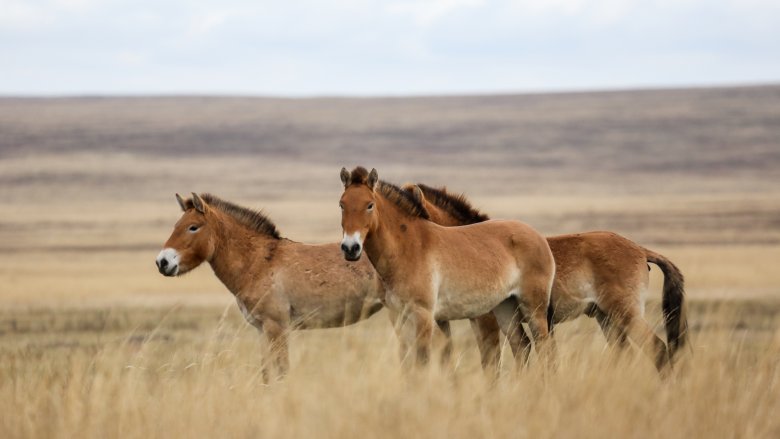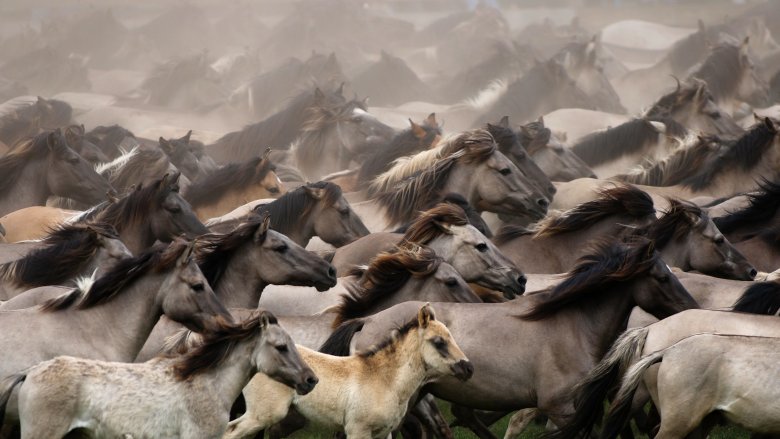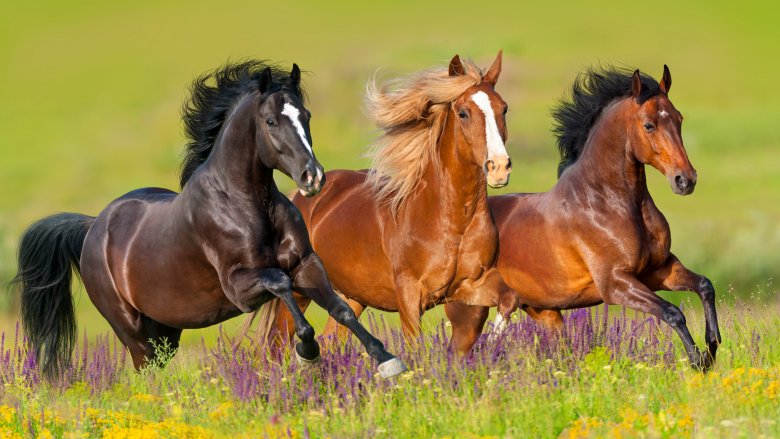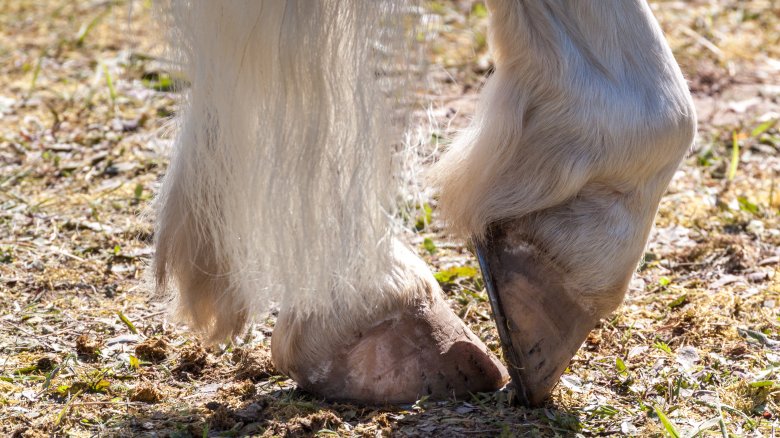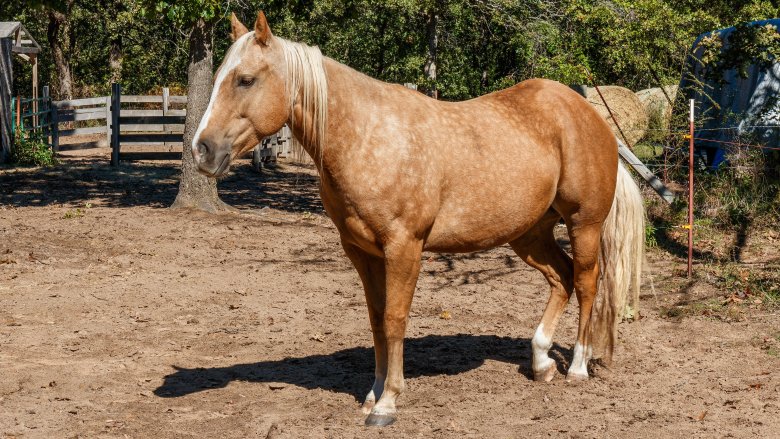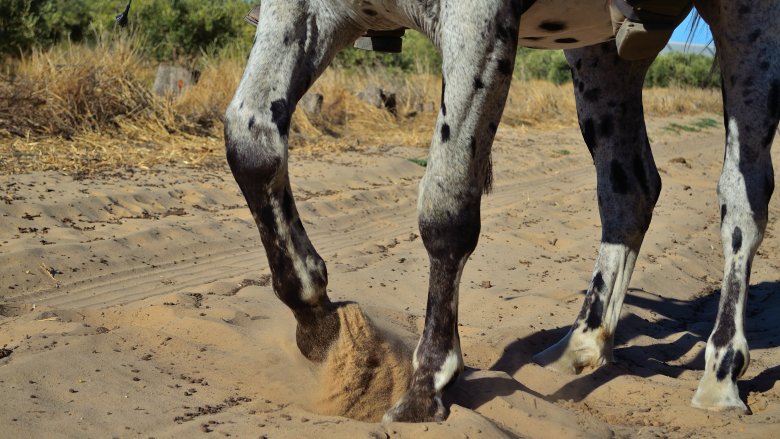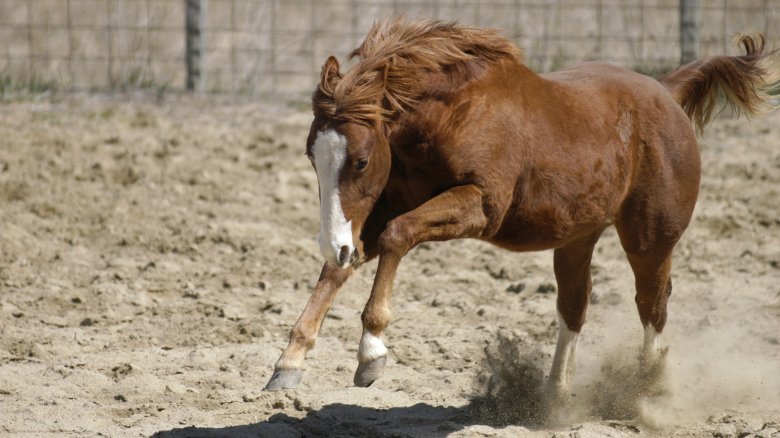The Real Reason Horses Buck (And Other Cool Horse Facts)
There's no denying the fact that horses have changed the course of human history. They revolutionized warfare, helped humans travel the globe, and made trade possible, and they've done it all simply because we've tied them up and asked nicely. They're probably as important to human culture, society, and history as dogs are. But how much do you really know about them?
Do horses sleep standing up?
It might be one of the first things you learned about horses: they sleep standing up. Like a lot of kindergarten facts, this one was made simple so Mini You could understand it. Horses — along with other big animals like moose and bison — can doze off standing up. According to Amy Johnson from the University of Pennsylvania School of Veterinary Medicine, they can nod off on their feet because of something called a "stay apparatus," a set of extra ligaments that allows them to stay upright without using a lot of energy. There's a practical reason for those extra bits. Horses are prey animals, so dozing off while they're standing can mean an extra split second of escape time.
For the rest of the answer, we look to Equus magazine. It says there are three phases of horse sleep. The first is a state of rest and the second is a deeper snooze; both of those happen when horses are standing. The deepest state, called the paradoxical phase, is like REM sleep in humans. Horses need to lie down for deep sleep, and they need between 30 and 60 minutes of it a day. If they don't get it, they can suffer from the same kind of sleep deprivation symptoms you do after a night of binge gaming. A sleep-deprived horse can even develop narcolepsy and collapse to the ground to sleep. Moral of the story? Let sleeping horses lie.
Do horses really love sugar cubes?
Of course horses love sugar; why wouldn't they? It's delicious! But there's a catch. Sugar isn't any better for them than it is for us, and too much of it can lead to serious problems. According to Equisearch, horses can develop diabetes, insulin resistance, and blood-sugar problems just like people can. There are a few different names for it — like equine metabolic syndrome — but the effects are the same. Telltale signs your horse needs to lay off the sugar, and that includes weight gain and the development of fatty deposits. Sounds pretty human, doesn't it?
According to studies done at the University of Queensland, a high sugar content in a horse's diet can also contribute to the development of laminitis, a pretty horrible condition where the horse's hoof layers detach from the bones in the foot. It's such a problem that commercial feed companies offer foods with no added sugar because some horses are more susceptible to issues. Sometimes, it can even be traced through a family line. So remember, just because they like it, that doesn't mean they should have it. How about a nice apple instead?
When did we first try to ride horses?
The idea of riding horses is commonplace today, but the first person who hopped on the back of one? That was either some serious thinking outside the box or an instructive lesson on the effects of alcohol. There will probably always be debate about the specifics of domestication, but the University of Cambridge's Department of Zoology thinks it has this horse thing figured out.
When researchers traced ancient horses back and back and back some more, they found the earliest signs of domesticated horses went back an insane 160,000 years. At the time, they weren't even our modern horses, they were a now-extinct creature called Equus ferus. The first person who yelled "Hold my spear" before vaulting onto the back of a presumably tolerant horse lived in the western Eurasian Steppe. That intrepid daredevil changed the world.
How the heck can a horse be cold-blooded?
Your basic biology classes were right about one thing: mammals are warm-blooded. So why are some horses called "cold-blooded"? Are there particularly reptilian-like horses? And if so, will the Illuminati take everything we hold dear?
Unfortunately, you won't see any half-lizard, half-horse creatures anytime soon, but there are cold-blooded horses. In horse terms, "blooded" refers to temperament rather than biology. Unsurprisingly, there are cold-blooded, hot-blooded, and warm-blooded horses. Cold-blooded horses are the most mild-mannered of the horse world, and they're the big, slow, and strong guys. Draft horses like Clydesdales and shire horses are cold-blooded. Because they can weigh up to 2,400 pounds and because they were bred to haul things like timber and canal barges, you don't want them to be jumpy or easily spooked.
On the other end of the spectrum are the hot-blooded horses; they're light, fast, and generally hard to handle. They're the long-distance runners and the racehorses, and most of these breeds — like the Arabs and the Akhal-Tekes — are selectively bred for their energy and all the chaos that goes along with it. In between are the warm-bloods, like the quarter horse. Warm-bloods are more athletic than the cold-bloods, more level-headed than the hot-bloods, and sort of the jack-of-all-trades of the horse world.
How did horses evolve?
Here's another thing you can tell your elementary school teachers they were really wrong about, especially if you remember seeing the charts of horse evolution that include some little dog-like creatures from the horses' relative recent history. Horses haven't evolved nearly as much as we thought, but (like all good things) it's complicated.
In 2013, evolutionary geneticists from the University of Copenhagen published their findings on a 700,000-year-old horse bone recovered from the Yukon. They were able to reconstruct a complete genetic sequence, and it was detailed enough they were able to go back even farther to figure out our modern horses, zebras, and donkeys all came from a common ancestor that lived between 4 million and 4.5 million years ago. (How they know this? We don't pretend to understand it.) That's not just a long time ago, it's farther back than we used to think, which means horses are evolving much more slowly than we believed.
When a research team from the Museum fur Naturkunde in Germany looked at 138 horse species stretching back 18 million years, they found many similarities between the different species and could only find three "bursts" of evolution that resulted in new species. That's the exact opposite of what they expected to find. The only true wisdom is knowing that you know nothing.
What's the deal with wild horses?
Let's get this one out of the way first — mustangs aren't wild horses. According to LiveScience, mustangs forfeited their "wild" designation because they're the descendants of domesticated horses brought over by European settlers. In fact, there are only two official types of wild horses we've ever discovered: the tarpan and the Przewalski's horse.
Humans have managed to wipe out the tarpan. The last wild one was chased off a cliff in Ukraine in 1879, and the last individual in captivity died in Moscow in 1887. But during World War II, German scientists were looking into resurrecting some extinct species and honed in on the tarpan as the perfect animal to represent the ingenuity and power of the Third Reich. According to the Smithsonian, they started selectively breeding horses for tarpan-like traits. While the tarpan didn't come back, those Nazi horses were sent to a remote Polish forest before the end of the war. They survived the war and their descendants are still there, but they aren't tarpans. Close, but not quite.
The Przewalski's horse (and that's "shuh-VAL-skee") hadn't fared much better. It thrived on the Mongolian steppes, but between its official discovery in 1881 and 1945, we wiped out the entire population save for 31 horses. There were 12 by the end of the 1950s, and according to Scientific American, all the P-horses in the world today are descendants of only nine of those horses. We've since reintroduced them to their native plains, and they're still completely untamed. And gorgeous.
How is the herd organized?
It's important to keep horses in a herd, even if that herd only has a handful of individuals. They're social animals, and the herd helps them feel safe and stay sane.
A group of horses will sort out a pecking order, and according to the founder of the University of Pennsylvania's equine behavior program, Sue M. McDonnell, the more clearly defined the herd hierarchy is, the happier everyone will be. You can tell everyone's getting along when they're just sort of hanging out or grooming each other. Fighting isn't even necessarily a bad thing unless it gets particularly violent; they're just confirming exactly where they rank.
Researchers have learned that there's a leader — who decides when the herd moves — and there's a dominant horse, but they aren't always the same horse. There are also subgroups of "friends," rivalries between individuals and groups, and occasionally, there's a horse that everyone else picks on. Needless to say, it's just as complicated as a group of sorority sisters, but for horses, it's necessary for their health, happiness, and survival. Sororities aren't so necessary.
What makes thoroughbreds so fast?
When it comes to hitting top speeds over short distances, no horses are better than thoroughbreds. There's a reason they're the horses exploited the most when it comes to the racing world, and according to research published in the journal Nature, it's genetic.
The thing that makes thoroughbreds so good at sprint racing is something called the C-variant of the myostatin gene. The most successful thoroughbreds in history all had the gene, and it can even be traced back to the 1700s. The gene was fairly rare into the 20th century, but that started to change in the 1950s. A stallion named Nearctic was born in 1954, and he passed the gene onto another stallion — Northern Dancer — who was born in 1961. Northern Dancer's offspring would be shipped off to four continents, win millions, and go on to continue to spread that gene mutation, in spite of Northern Dancer's insane stud fee of $1 million. That rare gene was suddenly widespread, and thoroughbred racing suddenly got a lot faster.
Are horses usually left- or right-hoofed?
We know most humans are right-handed, plenty are left-handed, and some annoying overachievers can do both. But according to Barefoot Health, horses are also right-hoofed or left-hoofed, and it's a lot more complicated than just remembering where they're going to be seated at the party.
You can tell by noticing which foot a horse tends to lead with when they start walking; some even have a hoof that's a little bigger than the other. It sounds like something only the blonde girl with the spotless boots at the dressage competition would care about, but it's actually important. A horse that's strongly right-side dominant will have trouble performing certain maneuvers that rely on them turning left and coordinating the left side of their body. Whichever side is dominant will have better muscle development and tone, and it'll be stronger and more coordinated. If you're training a horse — instead of just hopping on after someone else has done all the hard work — knowing that running in a certain direction is physically awkward for him goes a long way in communication and understanding. It's like trying to play your go-to video game with controller upside-down or with the mouse on the other side. Go on, give that a try.
What does it mean when my horse...
Watch any bad Western movie, and you'll probably start to think every time a horse cocks his hind leg, it's a warning someone is about to get kicked in the you-know-where. But that's not always true, says Equus, and sometimes a cocked back leg just means a horse is in 100 percent chill mode, like in the photo above. Horses often use the whole body to communicate. When you see the leg cocked, the horse's head down, eyes partially closed, and ears relaxed, it's chill time. But if the leg is cocked and the head is up and weaving? Ears pinned back? Get the heck away, because he's about to go nuclear.
There are so many minute gestures and expressions that a horse makes, it would be entirely possible to write a few dictionary-sized books on the subject. If you want the version that's shorter than War and Peace, learn about the ears. Ears forward means the horse is alert, paying attention to something, and probably deciding how it feels about this Potentially Scary Thing. Ears back is a danger signal, and sideways ears generally means the horse is relaxed, chilling, and might not be paying the least bit of attention to you. Rapidly moving ears? That's another sure sign of an angry horse. It that can happen a lot; know your signals!
Are broken bones always a fatal injury?
Every so often you'll see some really unhappy headlines from the racing world, maybe about a promising young horse being euthanized after shattering a leg. Because people are generally horrible, we still insist on pushing horses to the very brink of their physical capabilities for our entertainment, and stuff like Eight Belles' horrific 2012 collapse on the track of the Kentucky Derby is what we have to show for it.
According to the American Association of Equine Practitioners, the reason broken bones are often fatal is because taking a load off those bones and allowing them to heal just isn't an option with a horse. They aren't going to kick back and relax for a while. Keeping a horse immobilized slows its heart rate and cuts off circulation, which leads to other problems. According to the UC Davis Center for Equine Health, through, advances in equine medicine could mean some broken bones aren't the end of the line for some cases ... we hope.
What gives horses their gaits?
Hop on any horse, and you can put them through their paces. Horses will walk, trot, canter, and finally gallop, but some horses have another gait called ambling, tolting, or racking. It's a smooth gait somewhere between a walk and a gallop, as seen above. Only some horses — like the Tennessee walking horse — can amble, and according to the Smithsonian, we've discovered the gene that allows them to do it. It's called the gaitkeeper gene, and if they have it, they can amble. If they don't, there's no amount of training that will make them amble, proving that practice doesn't always make perfect.
The gene is spread throughout horses all over the world, so what gives? Researchers looked at DNA sequences of horses dating back to 6,000 B.C. and found the gaitkeeper gene spread with the Vikings and their Icelandic horses. As they were looting and pillaging and burning, they were also bringing their horses along with them. Early horses with the gaitkeeper gene spread to Britain through the rather up-and-down trading alliances, so hey, the Vikings weren't all bad — they brought along the idea of a smooth ride and leather seats.
Why do horses buck?
Horse behavior and communication is ridiculously complicated, and there's no single reason why a horse bucks. Experts interviewed by The Horse give a whole list of reasons for bucking, from just getting rid of extra energy to being a play behavior, a display of aggression, or expressing the opinion that there's something really annoying nearby. Bucking horses might be trying to escape an uncomfortable situation, particularly if they do it when they're annoyed with a rider or if they're in pain. They could be avoiding something they don't like, they could be being jerks on purpose, or they could just be having a bit of fun. Each situation is different, and it's only by reading the rest of the horse's body language that you can really figure out what's causing it and how to address it. No one wants to be near a bucking horse or on a bucking horse. Not cool, horse!
